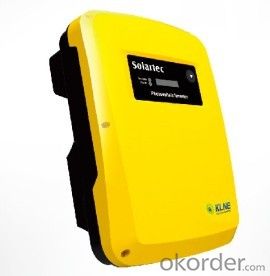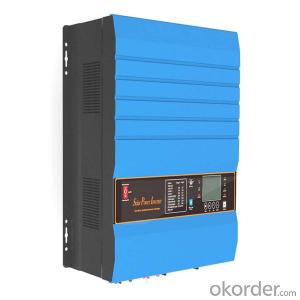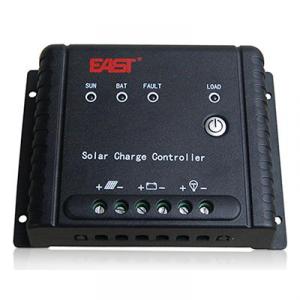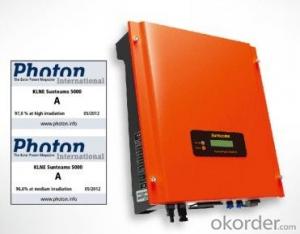Solartec 4600 KLNE on grid inverter with WIFI
- Loading Port:
- Shanghai
- Payment Terms:
- TT OR LC
- Min Order Qty:
- -
- Supply Capability:
- 10000 set/month
OKorder Service Pledge
Quality Product, Order Online Tracking, Timely Delivery
OKorder Financial Service
Credit Rating, Credit Services, Credit Purchasing
You Might Also Like
Solartec 1500,2000,2500,3000,3600,4000,4600,5000
1MPPT, single phase
IP 65
New mold with Pure thick aluminum crust.
Efficient
■ Efficiency of up to 97.6 %
■ TransformerlessSafe
■ Integrated DC switch
■ Comprehensive protection functionsFlexible
■ LCD backlight
■ For indoor and outdoor installationSimple
■ ‘Plug and play’connection for easy installation
■ Friendly interface, easy to install and maintain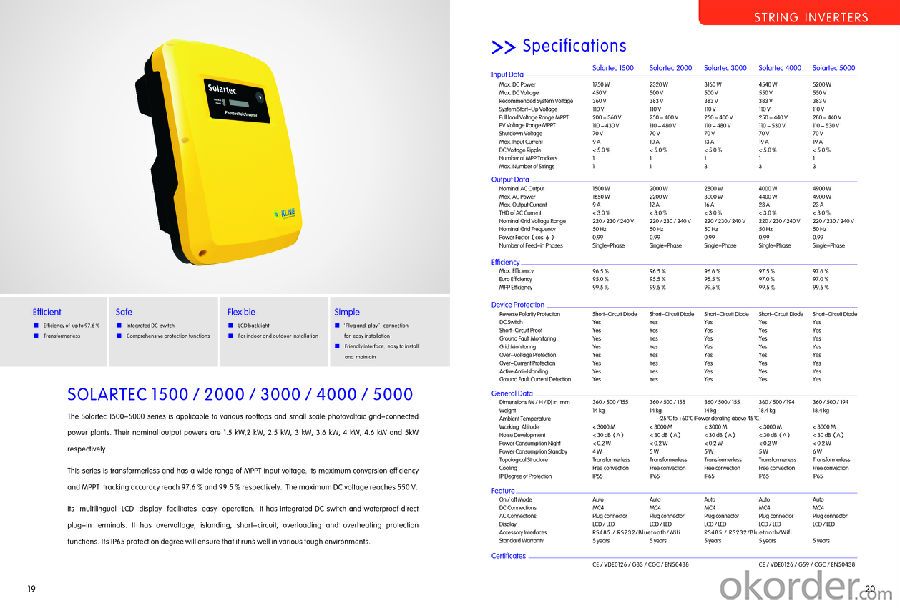
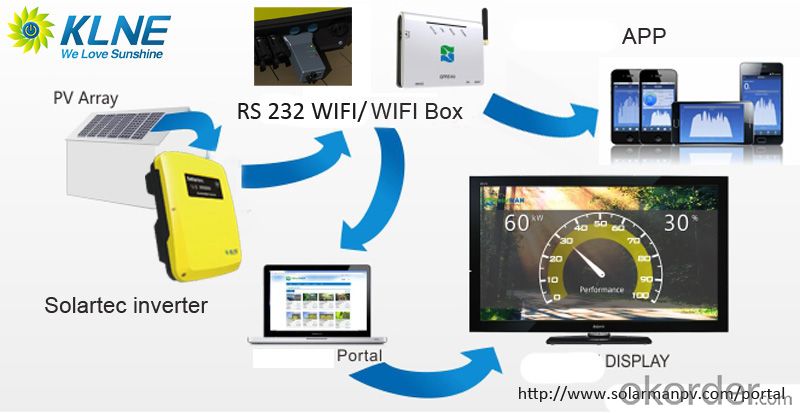
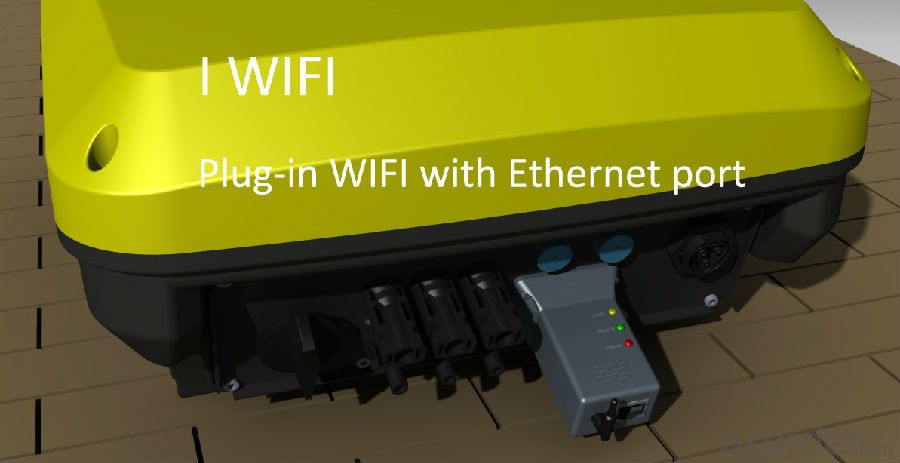
- Q: How do you choose the right voltage rating for a solar inverter?
- When choosing the right voltage rating for a solar inverter, it is important to consider a few factors. Firstly, you should check the voltage rating of your solar panels to ensure compatibility with the inverter. Secondly, consider your system's voltage requirements, including the voltage of your battery bank or grid connection. Lastly, take into account the distance between your inverter and the solar panels, as voltage drop can occur over long distances. By considering these factors, you can select a solar inverter with the appropriate voltage rating for optimal performance and efficiency.
- Q: How efficient are solar inverters?
- Solar inverters are highly efficient, with most modern models achieving efficiency levels of 95% or higher. This means that they can convert a significant amount of the DC power generated by solar panels into usable AC power for homes and businesses, minimizing energy losses and maximizing the overall efficiency of the solar system.
- Q: How do you calculate the power output of a solar inverter?
- To calculate the power output of a solar inverter, you need to multiply the input voltage by the input current. This will give you the input power. Then, multiply the efficiency of the inverter by the input power to get the output power.
- Q: Grid-connected inverter is generally divided into photovoltaic power generation grid-connected inverter, wind power grid-connected inverter, power equipment and grid-connected inverter and other power generation equipment power generation inverter.
- Grid-connected inverter is generally used with large-scale photovoltaic power plant system, a lot of parallel PV string is connected to the same set of inverter DC input, the general power of the use of three-phase IGBT power module, power
- Q: How does a solar inverter handle variations in solar panel cleanliness?
- A solar inverter can handle variations in solar panel cleanliness by continuously monitoring the output power and adjusting the operating parameters accordingly. If the panels are dirty, the inverter will detect a decrease in the output power and adjust the voltage and current to maintain optimal performance. However, if the panels are excessively dirty, it can significantly impact the overall energy production and may require manual cleaning to ensure maximum efficiency.
- Q: Can a solar inverter be connected to a smartphone app for monitoring?
- Yes, a solar inverter can be connected to a smartphone app for monitoring. Many solar inverter manufacturers offer mobile apps that allow users to monitor and control their solar power systems remotely through their smartphones. These apps provide real-time data on energy production, system performance, and can also enable users to adjust settings and receive alerts or notifications related to their solar power system.
- Q: Can a solar inverter be used with a monitoring system?
- Yes, a solar inverter can be used with a monitoring system. In fact, many solar inverters are equipped with built-in monitoring capabilities, allowing users to track the performance and output of their solar energy system in real-time. Additionally, there are also external monitoring systems available that can be integrated with a solar inverter to provide more advanced monitoring features and data analysis.
- Q: What is the role of a solar inverter in a grid-tied system?
- The role of a solar inverter in a grid-tied system is to convert the direct current (DC) electricity generated by the solar panels into alternating current (AC) electricity that can be used to power electrical appliances and be fed back into the utility grid. It also ensures the synchronization of the solar system with the grid and regulates the voltage and frequency of the electricity being produced.
- Q: Can a solar inverter be used with a solar-powered vehicle?
- Yes, a solar inverter can be used with a solar-powered vehicle. The solar inverter is responsible for converting the DC power generated by the solar panels into AC power that can be used to power various devices and components in the vehicle, such as the motor, lights, and electronics.
- Q: Can a solar inverter be used in conjunction with a wind turbine?
- Yes, a solar inverter can be used in conjunction with a wind turbine. Both solar panels and wind turbines generate DC (direct current) power, which needs to be converted to AC (alternating current) power for use in homes and businesses. Solar inverters are designed to convert DC power from solar panels to AC power, but they can also be used to convert DC power generated by wind turbines. By connecting a wind turbine to a solar inverter, the DC power generated by the wind turbine can be converted to AC power and used to power electrical devices or be fed into the grid. This allows for the integration of multiple renewable energy sources, such as solar and wind, in a single system, providing a more reliable and efficient energy generation solution.
Send your message to us
Solartec 4600 KLNE on grid inverter with WIFI
- Loading Port:
- Shanghai
- Payment Terms:
- TT OR LC
- Min Order Qty:
- -
- Supply Capability:
- 10000 set/month
OKorder Service Pledge
Quality Product, Order Online Tracking, Timely Delivery
OKorder Financial Service
Credit Rating, Credit Services, Credit Purchasing
Similar products
Hot products
Hot Searches
Related keywords


